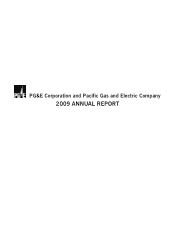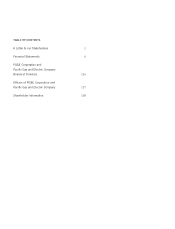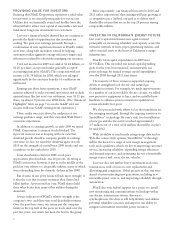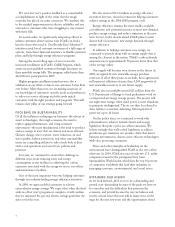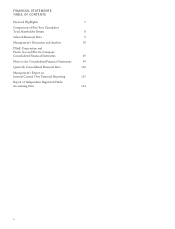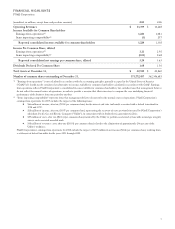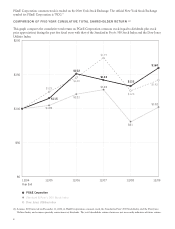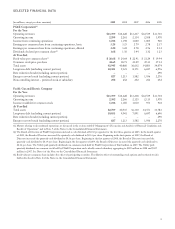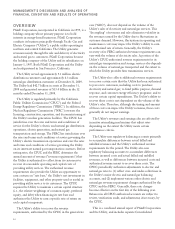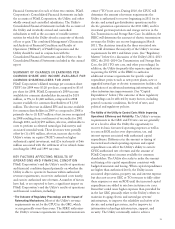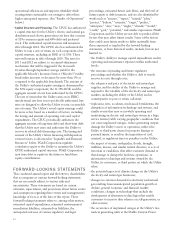PG&E 2009 Annual Report Download - page 6
Download and view the complete annual report
Please find page 6 of the 2009 PG&E annual report below. You can navigate through the pages in the report by either clicking on the pages listed below, or by using the keyword search tool below to find specific information within the annual report.PROVIDING VALUE FOR INVESTORS
Ensuring that PG&E Corporation represents a solid value
for investors is an essential prerequisite for our success.
Utilities that are financially sound and healthy have the
wherewithal to attract new capital at reasonable costs and
fund smart long-term investments for customers.
Last year’s financial results showed that we continue to
provide the kinds of opportunities that investors are
seeking. We grew core earnings primarily through a
combination of new capital investments in PG&E’s utility
asset base, along with incentives earned by helping
customers realize aggressive energy efficiency targets and
efficiencies realized by effectively managing our resources.
Total net income for 2009 was solid at $1.22 billion, or
$3.20 per share, as reported under generally accepted
accounting principles (GAAP). This compared with net
income of $1.34 billion for 2008, which was enlarged
significantly by the one-time benefits of a multiyear tax
settlement.
Earnings per share from operations, a non-GAAP
measure adjusted to reflect normal operations and exclude
unusual items like last year’s tax settlement, were $3.21 per
share, up almost 9 percent over 2008 levels. (The “Financial
Highlights” table on page 7 reconciles GAAP total net
income with non-GAAP earnings from operations.)
These results were just above the midpoint of our
earnings guidance range, and they exceeded Wall Street’s
consensus expectation.
In addition to earnings growth, in early 2009 we raised
PG&E Corporation’s common stock dividend. The
8 percent increase was in keeping with our view that
dividend growth should accompany growth in earnings
over time. In fact, we raised the dividend again in early
2010 on the strength of our full-year 2009 results and our
confidence in the outlook for 2010.
Total shareholder return for 2009—stock price
appreciation plus dividends—was 20 percent. As strong as
PG&E’s return was, however, it put us in the middle of the
pack last year relative to comparable utilities, many of which
were rebounding from the dramatic decline in late 2008.
But if some of our peers bounced back more strongly, it
is also the case that in many instances their shares had
fallen further. As we noted last year, PG&E shares held
their value better than many other utilities during the
downturn.
A truer indication of PG&E’s relative strength is the
company’s two- and three-year total shareholder returns.
Over the past three years, our return put the company
firmly in the top half of the peers we track. And over the
past two years, our return has been the best in the group.
More importantly, our financial forecasts for 2010 and
2011 reflect expectations that earnings will keep growing at
a competitive pace. Indeed, our goal is to deliver total
shareholder returns that are in the top 25 percent among
comparable utilities.
INVESTING IN CALIFORNIA’S ENERGY FUTURE
Last year’s capital investment once again focused
principally on increasing reliability and capacity across the
extensive network of wires, pipes, generating stations, and
other essential assets at the heart of California’s energy
infrastructure.
PG&E’s total capital expenditures in 2009 were
$3.9 billion. This exceeded our initial capital spending
goals for the year, but remained consistent with our
projected range for annual average capital expenditures
over the 2008 through 2011 time frame.
The majority of these resources supported ongoing
efforts to strengthen local electric and natural gas
distribution systems. For example, we made improvements
to a number of our least reliable electric circuits, we added
new protective equipment to lines, and we installed new
hardware to enhance power restoration capabilities in
certain reliability hot spots.
We also proceeded with efforts to lay the foundation for
the emerging smart grid, through the ongoing transition to
SmartMeter™technology. By year’s end, total installations
of new gas and electric meters reached approximately
4.5 million out of a total of 10 million that will be in place
by mid-2012.
With its ability to send timely energy-usage data and its
Web-like connectivity options, SmartMeter™technology
will be the basis for a range of new energy management
tools and capabilities, which are key to improving customer
service, increasing reliability, expanding energy efficiency
and demand response, and optimizing the use of renewable
energy sources and, soon, electric vehicles.
Last year also saw further heavy investment in electric
transmission, with a focus on asset replacement and
alleviating grid congestion. Other projects in this area were
aimed at interconnecting new generation, including new
renewable power sources, and improving reliability through
automation.
PG&E also won federal support for a project to install
new monitoring and communications technology within
our electric transmission system. Known as
synchrophasors, the devices will help identify and address
potential reliability concerns and improve our ability to
integrate intermittent renewable power resources.
2

